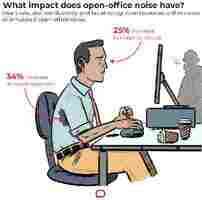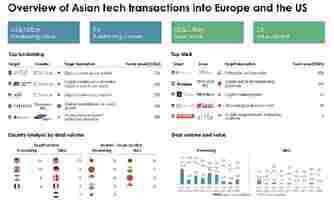Open-plan offices make you stressed and moody: We’ve got the data to prove it
If you’ve ever felt your noisy open-plan office makes you cranky and sends your heart racing, our new research shows you aren’t imagining it.

Prior to the pandemic 70% of office-based employees worked in open-plan offices. Employee complaints about this design are rife .
Yet there is little experimental research investigating the effects of office noise on things like cognitive performance, physiological stress , and mood.
The results of our study , in experimentally controlled conditions using heart rate, skin conductivity, and AI facial emotion recognition, shows the effects of that noise are very real.
We’ve found a significant causal relationship between open-plan office noise and physiological stress.
Our results show such noise heightens negative mood by 25% — and these results come from testing participants in a simulated open-plan office for just eight minutes at a time. In a real office, where workers are exposed to noise continuously during the day, we would expect the effects on stress and mood to be even greater.
How we simulated open-plan office noise
We used a simulated office setting with volunteers to compare the effects of typical open-plan office noise to a quieter private office on a range of objective and subjective measures of well-being and performance. Our carefully manipulated soundscapes included people speaking, walking, printing papers, ringing telephones, and keyboard typing noises.
Our study involved observing the same individuals “working” — participants were asked to complete a proof-reading task — under the two noise conditions. We varied the order of the sound tests to avoid bias due to fatigue and training effects.
This “repeated measures experimental design” allowed us to make causal conclusions about the effects of the noise on well-being indicators.
We used sensors to track changes in heart rate and sweat response — both reliable indicators of physiological stress. We used facial emotion recognition software to assess emotional responses. We also had participants self-report their own feeling using a mood scale .
Even after a short exposure, we found a causal relationship between open-plan office noise and both stress and negative mood. Negative mood increased by 25% and sweat response by 34%.
While there was no immediate effect on reduced work performance, it is reasonable to assume such hidden stress over the longer term is detrimental to well-being and productivity.


Precise causal relationships
Our study addresses a gap in the literature by using a simulated office environment with objectively manipulated noise levels and a wide range of objective and subjective dependent variables.
Reviews in research in this field show past studies have tended to only use self-reported measures. They have not used controlled experimental conditions, nor tested sound parameters.
Comparing multiple output measures has allowed us to investigate cause-effect relationships. Much research on open-plan offices has not established direct causal connections, which is necessary to understand precise relationships, and thus the how to most effectively and efficiently reduce these stressors.
Although open-plan offices rarely present an immediate physical danger in terms of sound levels, unrelenting exposure all day intensifies their effects.
Chronically elevated levels of physiological stress are known to be detrimental to mental and physical health.
Frequently being in a negative mood is also likely to harm job satisfaction and commitment. It potentially increases the likelihood of employees leaving.
What to do about it
The pandemic has changed our tolerance for office work. Surveys show up to 70% of employees will seek new jobs if their employer does not offer flexibility to work from home some of the time. So creating a healthy work environment is more important than ever.
As organizations seek to adapt to COVID-19, many are reconsidering how they set up and use the office. Though open-plan offices are unlikely to go away any time soon, our study highlights the importance of understanding employee needs in designing work spaces.
One advantage of more employees working from home at least some of the time is a less crowded office, reducing both visual and auditory distractions.
But there are other things that can be done. Acoustic treatments and sound-masking technologies — ambient sounds designed to make other people talking less intrusive — can help. Good old-fashioned walls or partitions may also assist .
Such interventions can be costly, but so is the impact of poor office environmental quality on productivity .
And we might all feel happier about going back to the office.
Article by Libby (Elizabeth) Sander , Assistant Professor of Organisational Behaviour, Bond Business School, Bond University .
This article is republished from The Conversation under a Creative Commons license. Read the original article .
Chinese investors spent the same on European tech as in US companies, Q1 report says
Chinese investors are deepening their ties with the European technology community — so it looks like you should broaden your horizons when looking for funding.

A new report by GP Bullhound states that Chinese investment into European tech has caught up with that into the US for the first time since Q1 2018.
The report, titled ‘Asia Insights: Q1 wrap-up from one of the first markets to reopen,’ says that tech investment in the US reached a historical low in Q1 — with little sign of recovery considering the tense relationship between the Western country and China.
Tencent, it adds, boosted its presence in the European ecosystem by making five transactions, including two in fintech, one in digital media, one in marketplaces, and one in the software space.
Sony, NTT Group, Hyundai, Samsung, and Itochu poured $400 million into markets including the US, Israel, and Spain.


SoftBank closed six deals in Q1. Together with Temasek, the firm accounted for more than 49% of Asian financial investors’ money into Europe and the US .
On the flipside, European also increased inbound tech investment in Asia , while the US slowed its pace.
According to the report, European investors spent $700 million across 36 deals, mainly in China and Southeast Asia .
US investors , however, scaled back by completing smaller deals, and focused mostly on India , Southeast Asia , and other non-China markets .
The report says Japan became the most active Asian tech investor in Europe and the US in Q4 2019, and continued to lead the ranking during the first quarter of 2020.
Japanese investors focused on software companies across Europe and the US.
Back in April a report by PitchBook estimated that v enture capital investors spent €8.2 billion into European companies during the first quarter of 2020.
According to PitchBook’s European Venture Report Q1 2020 , the first three months of 2020 constituted the fourth-strongest quarter ever in terms of total deal value in Europe.
However, although activity seemed to get off to a good start in 2020, the report predicted the coronavirus pandemic would have a significant effect on deals in the ecosystem.
It also stated that the pandemic would threaten the flow of US capital into European tech companies — so I guess money from further afield would likely be welcomed.
Engagement isn’t the future of software — so stop prioritizing it
When’s the last time you thought about your hammer? Probably the last time you used it. Physical tools don’t ask for your time — they just do their job. Software , on the other hand, is also a tool, but lately, apps are demanding more and more of humans. Workplace software is just as addictive as consumer software, all in the name of “driving engagement.”

But who is this engagement really for? For most users, it only leads to irrelevant, or worse, distracting work. The constant red dot, the buzzing notification on your phone, and the chime of one more alert calls us to work that may or may not matter.
It’s overwhelming and pointless — so let’s stop doing it.
Don’t let software get in your users’ way
Imagine, if you will, a world in which hammers were optimized for engagement. They could maybe make a sound every day, just to remind you that you have a hammer.
They could have Wi-Fi, with push notifications, letting you know how many nails you drove in one year ago today. Maybe there’s the occasional note about new hammers you could purchase.
It’s a silly idea for a hammer. In a few years, people will also realize it was a silly idea for work software — so you better adapt.
People, and businesses especially, will increasingly look for software that’s less like a social network and more like a hammer. The future of software will be focused on enabling workers, not driving engagement. It’s about putting humans back in the driver’s seat.
People want software that allows them to have leverage over the work they do. To truly be able to do more things, with less. That means creating software people can use to do a job, then stop thinking about.
My co- founders and I founded Zapier on these principles — and I feel all software creators should do the same. We shouldn’t demand people’s time. Instead, we should give users the freedom and flexibility to do whatever they think is most important, while helping them automate the rest.
Let your apps work for you
The best employee is one you can trust to do their job without a lot of oversight. People who save you time, rather than take it up. Software should work the same way. People should be able to hire software to do a job, then trust it to get that job done without a lot of effort on their part.
Automation software is a great example of this. Creating automated workflows takes some time upfront, but after that, it works in the background. It saves users time every month, whether they log in to the website or not.
This is the future of software: apps doing more for us instead of demanding more from us. So if you want to succeed, apply this to the products you make, and help empower the next generation of creators.
This article by Wade Foster is based on a previous piece, originally published on the Zapier blog . You can read the original article here .